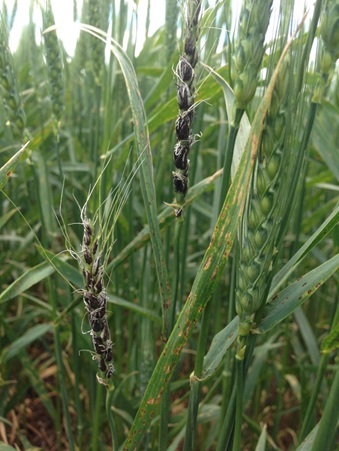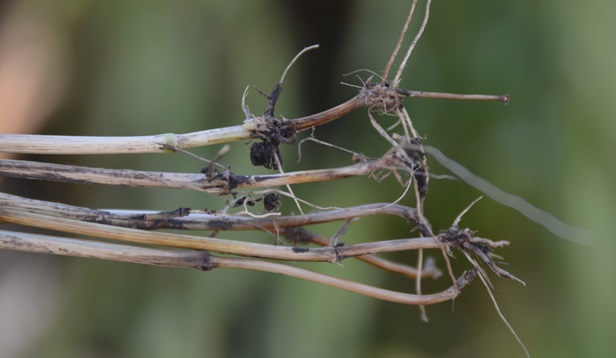Winter wheat planting is around the corner and growers may be contemplating whether to treat or not treat their wheat seed. Seed treatment can help in the management of seed-borne and soil-borne pathogens. Fungicide seed treatment can be effective especially for pathogens surviving on the seed surface or in the soil but also for the systemically infected seeds if the fungicide has systemic properties.
A distinction ought to be made between seed-borne and seed-transmitted diseases. Seed-borne diseases are caused by pathogens that survive on the seed surface (infested) but the seed itself is not infected (e.g. common bunt). Seed-transmitted diseases are those caused by pathogens that infect the seed and the seedling is therefore infected (e.g. loose smut, figure 1).
There are also diseases, like ergot, where the pathogen is not on the seed surface or inside the seed, but the sclerotia mimics the seed and is mixed with seed. For the soil-borne diseases, the pathogen survives in the soil and/or on the infected crop residue and attacks the seedling as it emerges (e.g. common root rot and foot and crown rots, figure 2).

|
|
Figure 2. Crown and sub-crown root rot pathogens survive on infected residues and in soil. |
Unlike foliar fungicides which are applied when disease symptoms can be seen, fungicide seed treatment is done without the knowledge of whether the disease will develop to become a concern. That’s why fungicide seed treatment is sometimes referred to as a form of cheap insurance, in that, if disease develops and seeds were seed treated, there is return on investment. But if there is no disease, there is no return on investment.
When deciding on seed treatment, consider if there has been a history of seed-borne/soil borne disease, if the crop is for seed production, if wheat will be planted into wheat stubble, time of planting (early planting may benefit from seed treatment), and if the germination rate of the seed lot is low. Fungicide seed treatment will not compensate for bad seed (e.g. shriveled, mechanical damaged or impure seed). It should be noted also that fungicide seed treatments are effective for up to 3 weeks, therefore, slowed seedling growth due to cool soil temperatures or favorable weather conditions for infection 3 weeks after planting may still pose a risk for potential seedling infections.

|
|
Figure 1. Loose smut of wheat. Spores from infected wheat heads are blown by wind and infect heads at the start of seed development. Infected seeds will give rise to infected heads, as seen in this photo. |
Other practices that limit seedling diseases and other diseases from developing like crop rotation, use of clean certified seed, use of resistant varieties, residue management, weed control (eliminate source of inoculum) and adjusting time of planting are strongly encouraged.
Several fungicide products approved for use in South Dakota are available on the market. If a history of reduced plant stand exits, then using a fungicide product with more than one active ingredient may increase the effectiveness of the seed treatment. If the wheat seed to be planted came from a field that had ergot, in addition to thorough cleaning, a fungicide seed treatment containing a triazole fungicide will reduce sclerotia viability.






Post a comment
Report Abusive Comment